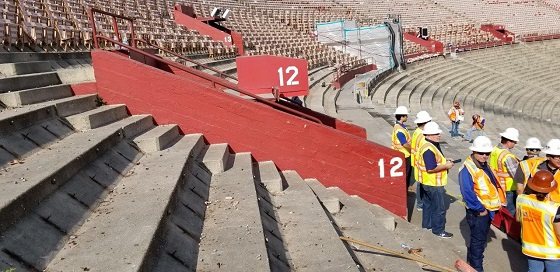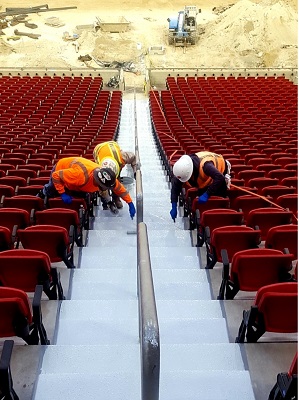The Los Angeles Memorial Coliseum, home of the University of Southern California (USC) Trojans, is known to many as “The Greatest Stadium in the World.” It is the only facility in the world to have hosted two Olympic games, two Super Bowls, a World Series, a Papal mass, and three U.S. presidential visits. Its third Summer Olympics are scheduled for 2028. The stadium, originally built in 1923, has quite a history — and an eventful future!
Beginning in January 2018, the L.A. Coliseum underwent a multi-million-dollar renovation. According to the USC Trojans’ website, “During the renovation, 46,000 cubic yards [35,169.5 m3] of dirt was exported, 470 truckloads of concrete was poured, 1,740 tons [1,578.5 metric tons] of rebar and 2,131 tons [1,933.2 metric tons] of structural steel was installed, and 4,618 gallons [17,481.0 liters] of paint was applied.”
Add to that “miles and miles of caulking,” according to Shaun Geiger, CEO of Angelus Waterproofing & Restoration Inc. out of nearby Huntington Beach, Calif. With about 100 employees between that main location and another down the coast in San Diego, Angelus was brought into the project in April 2019 to do spall repairs, sealant removal and replacement, and urethane traffic coating installation. And it all had to be ready in time for football season in mid-August.
Bringing Their “A” Game
The main focus of renovations to the stadium had originally been “the new press box and suites — the alumni suites,” said Stephan Claus, president of Angelus. After USC had spent a great deal of money on those areas, he added, “then the rest of the stadium didn’t look so good, so they said, ‘We need to do something.’ So coatings and new seats and rails is what changed it.”
As with many coatings jobs, the toughest part of the job was the surface preparation, but Angelus brought their “A” game to the field. In the 50,000 square feet (4,645.2 m2) where the Angelus crew of between 6 and 15 members worked, much of the concrete was stairs, though some was newly poured. It took a long time to get the stairs clean, according to Geiger, because the concrete was highly degraded.
The crew used four Predator 4,400 psi (30.3 MPa) pressure washers from Harbor Freight Tools connected to Bosch high-efficiency particulate air (HEPA) filter vacuums. Geiger said, “All the guys were wearing masks, all the PPE [personal protective equipment]. We had a silica control plan in place.” In addition to 3M respirators, the crew donned West Chester Posi Shield gloves, HD Supply White Cap hard hats, and safety glasses.
“Miles and Miles” of Caulking
Approximately 1,000 square feet (92.9 m
2) of spall repairs were another part of the surface prep on this job. Angelus crew members used angle grinders “to saw a square and a chipping hammer to chip them out,” Geiger said. “It’s like filling a cavity.” SikaTop-122 Plus trowel-grade repair mortar was used to patch the spalls, and coating over top of those would come later.
Angelus had to “come in and caulk everything, and there was a ton of caulking,” stated Geiger. “We didn’t just caulk where we coated. We caulked every joint in that whole bowl — around the tunnels, all the control joints, all the expansion joints.” The joints were caulked with Sikaflex-2C, and the crack repairs, penetrations, and footings received a bead of Sikaflex-1A.

“Then we had to come in and lay down the primer,” said Geiger. “And the primer was a really tough thing to do because of how rough the stairs were…. It was so rough, we had to go real heavy with the primer just to fill it in.” For this step, Sikalastic FTP Primer was used, which is part of the Sikalastic urethane deck coating system. However, a slower-curing version of the primer — an FTP low-VOC (volatile organic compounds) primer — as well as two crews were needed later on.
“Come July and August, it was getting extremely hot in there,” said Claus. “Usually you would prime and coat the same day, but if the sun is too hot, the coating will tend to bubble and blister. So what we had to do is talk to our manufacturer, and they gave us a slower-setting primer [so] that we could prime in the morning. Then, while the primer was drying, we sent the guys to do other scopes of work — crack repair injection, spalls, and so on. At the end of the day, they would all go home. At 3:30, we’d send a new crew in there, our nighttime crew, to do the coating. So that way, the temperatures are declining and there’s less chance of bubbling or blistering, and that’s what made it successful.”
No matter which version of the primer was used, a lot of it went down because of the roughness of the concrete. “You’d be going anywhere from 200 square feet a gallon down to 50 square feet a gallon [18.6 to 4.6 m2/3.8 L] if you had to,” said Claus.
Ready for Game Day
 At last it was time for the rest of the Sikalastic system. “Once we started putting the basecoat, intermediate coat, topcoat, that kind of started going easy. It was like 80 percent of the work happened before we started laying the urethane down,” said Geiger. The basecoat was Sikalastic 710, and the topcoat was Sikalastic 715.
At last it was time for the rest of the Sikalastic system. “Once we started putting the basecoat, intermediate coat, topcoat, that kind of started going easy. It was like 80 percent of the work happened before we started laying the urethane down,” said Geiger. The basecoat was Sikalastic 710, and the topcoat was Sikalastic 715.
“I believe the total thickness was close to 55 dry mils [1,397.0 microns],” commented Claus. “The topcoats go down at a minimum of 10–12 mils each [254.0–304.8 microns]…. But the basecoat, it went down to make it look good. It could be 20 mils [508.0 microns], it could be 30 mils [762.0 microns] to cover it. But we estimated a little bit on the fat side so we could take that into account.”
The crew applied the stair coatings with Marshalltown notched hand trowels. On large walkways, it was squeegeed and backrolled, said Geiger.
Throughout the job, the Angelus crew was challenged by not only the timeline but also having to work around other trades. “There was a lot — they were ripping out big, giant sections of the bowl and repouring the concrete,” said Claus. “We were having to work around them. We couldn’t coat it until they repoured it. Handrail companies that were putting in the handrails. Seat companies that were putting in the seats. It was a lot of coordination, and it was a really tight time schedule.”
“It was a pretty crazy, mad dash from the first day out there,” echoed Geiger.
“The other thing that was staring us down the eyes was the million-dollar-a-day liquidated damages if we did not finish on time,” said Claus. But in the end, Angelus completed the project on time and, according to Claus, “definitely gave [the stadium] a facelift. That’s probably the least amount of money they spent on that whole project, and I think it gave it the most bang for the buck in all reality. It was a great job. It was very, very nice.”
